|
|
|
Sort Order |
|
|
|
Items / Page
|
|
|
|
|
|
|
| Srl | Item |
| 1 |
ID:
192656
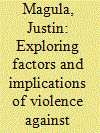

|
|
|
|
|
| Summary/Abstract |
The Soviet-Afghan War serves as a significant case study to understand why states resort to violent acts against civilians during war. This study takes a multidimensional approach, examining strategic, operational, and individual factors and applying theories of violence and mass killing. By analyzing the conditions that led the Soviets to target civilians, this investigation identifies a nexus of interconnected factors. At the strategic level, Soviet leaders pursued a swift victory to establish a Communist client regime while minimizing casualties and controlling information flow. Operationally, the ill-preparedness of the Red Army for counterinsurgency warfare, coupled with an entrenched organizational culture, led to the adoption of counterproductive enemy-centric tactics against Afghan noncombatants. Additionally, inadequate training, prolonged deployments, and a lack of disciplinary measures at the individual level contributed to the perpetration of violent acts. Understanding the underlying causes of violence against civilians, particularly in the context of Russian forces, holds practical importance. This knowledge can assist policymakers in devising strategies that mitigate wartime violence and enhance the protection of citizens. Drawing parallels to contemporary conflicts involving Russia, the study concludes by recommending future research directions and emphasizing the relevance of comprehending the targeting of noncombatants in ongoing conflicts, notably the Russian-Ukrainian conflict.
|
|
|
|
|
|
|
|
|
|
|
|
|
|
|
|
| 2 |
ID:
070802
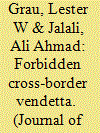

|
|
|
|
|
| Publication |
2005.
|
| Summary/Abstract |
In 1986, Soviet Special Forces conducted an unauthorized strike into Pakistan while attempting to wipe out a guerrilla base. The Special Forces were pinned down and had to call for Soviet air strikes to extricate themselves from an untenable position. This article discusses the planning, conduct and consequences of the mission.
|
|
|
|
|
|
|
|
|
|
|
|
|
|
|
|
| 3 |
ID:
185231
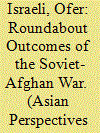

|
|
|
|
|
| Summary/Abstract |
This paper demonstrates that when a superpower within a bipolar system fights against a small rival either that is located beyond its sphere of influence or that has geostrategic importance to the other acting superpower, other forces matter more than the distribution of capabilities between the belligerents. Within the study I review two primary explanations for the Soviet withdrawal from Afghanistan. Despite the strong resistance of local forces to the Soviet presence in Afghanistan, mainly by the Afghan Mujahedeen, Moscow failed to predict the political outcomes of the war. It was in fact a series of negative feedbacks that caused Soviet withdrawal from Afghanistan after a decade-long intervention that did not achieve any political goals. One such example was the direct strike against the Soviet presence in Afghanistan, launched and coordinated by the United States as the other acting superpower under the bipolar system of that time.
|
|
|
|
|
|
|
|
|
|
|
|
|
|
|
|
| 4 |
ID:
139433
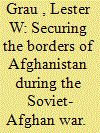

|
|
|
|
|
| Summary/Abstract |
During the 1979–1989 Soviet-Afghan War, the Soviets provided training, advice, and support to the Border Guard forces of the Democratic Republic of Afghanistan. Afghanistan shared borders with the Soviet Union, China, Iran, and Pakistan. The Soviets addressed the Iranian, Chinese, and Pakistani borders as any nation assisting another nation would. Afghanistan’s border with the Soviet Union was different. The Soviet Union increased its own border forces facing Afghanistan while moving Soviet border forces well within Afghanistan, creating a de facto Soviet border inside their neighboring country. The Afghan government ignored this challenge to national sovereignty. The Soviet border force was more than stationary outposts. It had ground maneuver and air assault battalions which swept the area in search of guerrillas.
|
|
|
|
|
|
|
|
|
|
|
|
|
|
|
|
| 5 |
ID:
158948
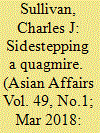

|
|
|
|
|
| Summary/Abstract |
Russia's military intervention in Syria (2015-present) has ensured the Assad regime's survival to date. Why though has Russia succeeded in achieving its objective? This article provides an analysis of Russia's involvement in the Syrian civil war in comparison to the Soviet Union's military debacle in Afghanistan (1979-89). Accordingly, by avoiding the USSR's mistakes in Afghanistan, this article posits that Russia has not become entangled in a protracted conflict in Syria. In Syria, Russia has militarily intervened to buttress the Assad regime, not to reorganize the host government's leadership and assume control over the war effort. Meanwhile, Syrian opposition forces lack concerted international support and Russia has allies that are assisting the embattled Syrian government. Lastly, Russia intends to ‘freeze’ the Syrian civil war in place by (i) pressuring opposition forces to submit and other countries to re-embrace Damascus in a diplomatic forum, (ii) endorsing Syria's claim to sovereignty, and (iii) relying upon a small military presence to deter others from destabilizing Assad's rule.
|
|
|
|
|
|
|
|
|
|
|
|
|
|
|
|
| 6 |
ID:
070803
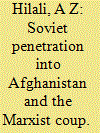

|
|
|
|
|
| Publication |
2005.
|
| Summary/Abstract |
Afghanistan is a landlocked country and a famous cockpit, as well as heart of Asia. It has long been a chessboard of power politics of the "Great Game" between many great powers. The country is a mosaic of races and ethnic communities and has a tribal and feudal structure. Historically, Afghanistan served as a showcase for the Russian and Soviet political and strategic interests and, in the recent past, Soviet political and economic influences fundamentally altered the domestic scene in the country. The monarchical era was replaced by democratization and the political process first gave rise to the dominance of the Marxist Peoples' Democratic Party of Afghanistan (PDPA) and, ultimately, the Saur Revolution of 1978, which brought the Marxists to full power. However, the PDPA's reforms de-stabilized the Communist regime as the Afghan masses reacted against them. Therefore, the Soviet Union invaded Afghanistan in 1979 to protect its client regime, which was on the edge of collapse.
|
|
|
|
|
|
|
|
|
|
|
|
|
|
|
|
| 7 |
ID:
083204
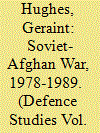

|
|
|
|
|
| Publication |
2008.
|
| Summary/Abstract |
The British military deployment to Sierra Leone in May 2000 marked therenewal of a long historical connection between the two countries. As aformer British colony, from 1829-1961 the authorities in London wereresponsible for providing the administration and governance of their West African territory as well as safe-guarding its security. This entailed thecreation of a dedicated local military structure, mixing local troops withseconded British officers to guard the frontiers of the small country againstboth external and internal threats. Although in a much revised form, thismission appears to have been now once again renewed.
|
|
|
|
|
|
|
|
|
|
|
|
|
|
|
|
| 8 |
ID:
179346


|
|
|
|
|
| Summary/Abstract |
The Afghan Taliban appear to be on the verge of reconstituting the so-called Islamic Emirate of Afghanistan proto-state that was toppled in late 2001 by U.S., coalition and indigenous forces. A series of factors indicate that the Afghan government could implode from within or be swiftly overthrown by the Afghan Taliban unless the United States continuously reinforces Kabul with ample political-military aid. In addition, any future U.S.-led military reengagement would likely amount to a replay of the events of late 2001 or worse, thereby prolonging the war. Lastly, there is little reason to expect that the Afghan Taliban leadership will temper its ideological aspirations, sever ties with designated terrorist groups, or moderate its governing style in return for international recognition or under threat of punitive repercussions. As such, how the United States manages its anticipated withdrawal in the coming months will have major ramifications, and America should prepare for the possibility of an historical recurrence of the collapse of the Afghan government reminiscent of the downfall of the Soviet-sponsored Communist regime in 1992.
|
|
|
|
|
|
|
|
|
|
|
|
|
|
|
|
|
|
|
|
|